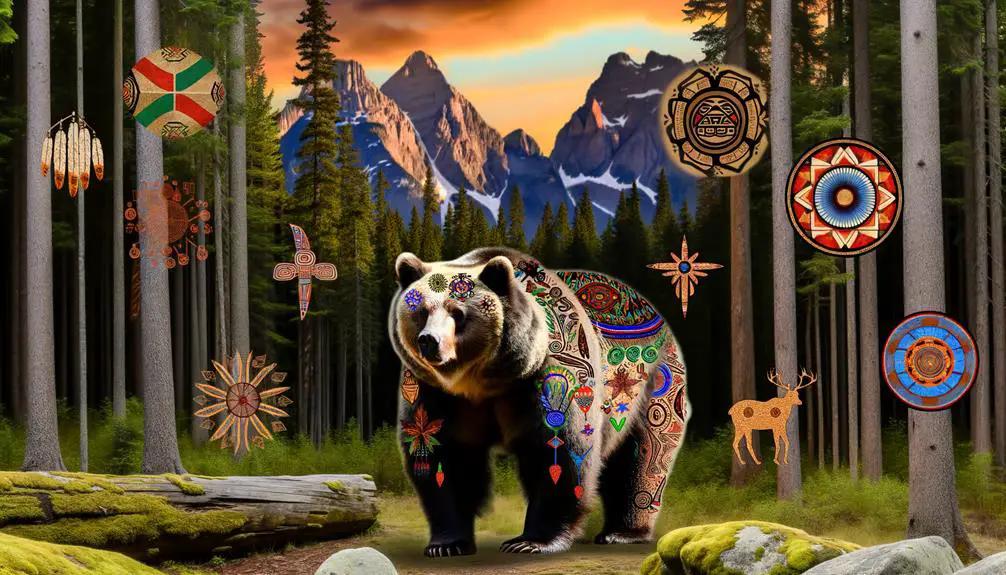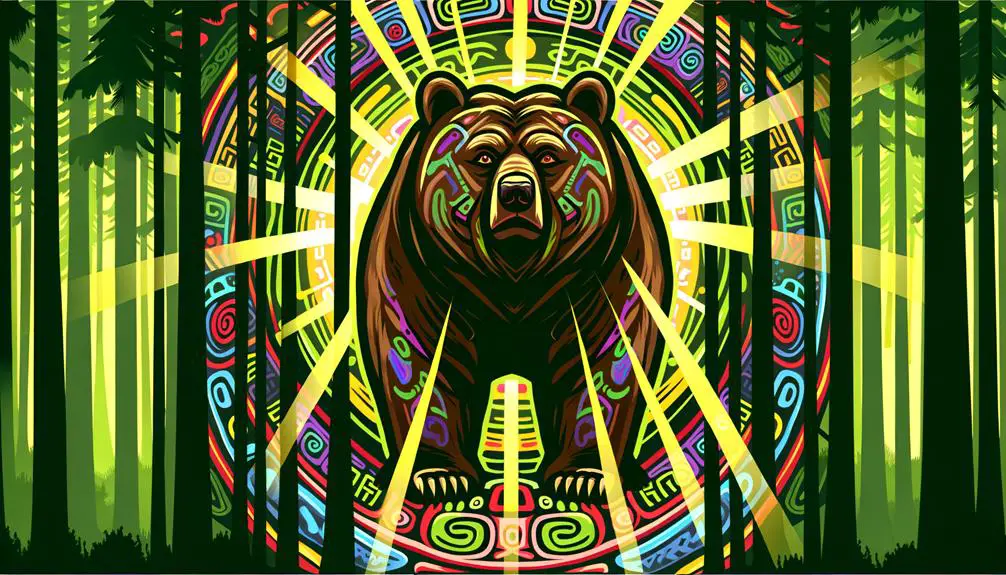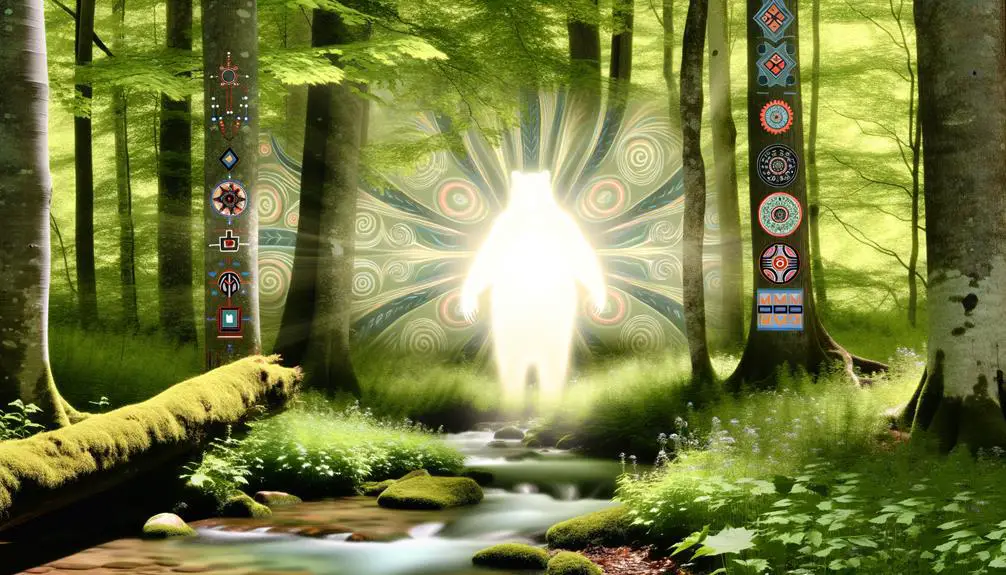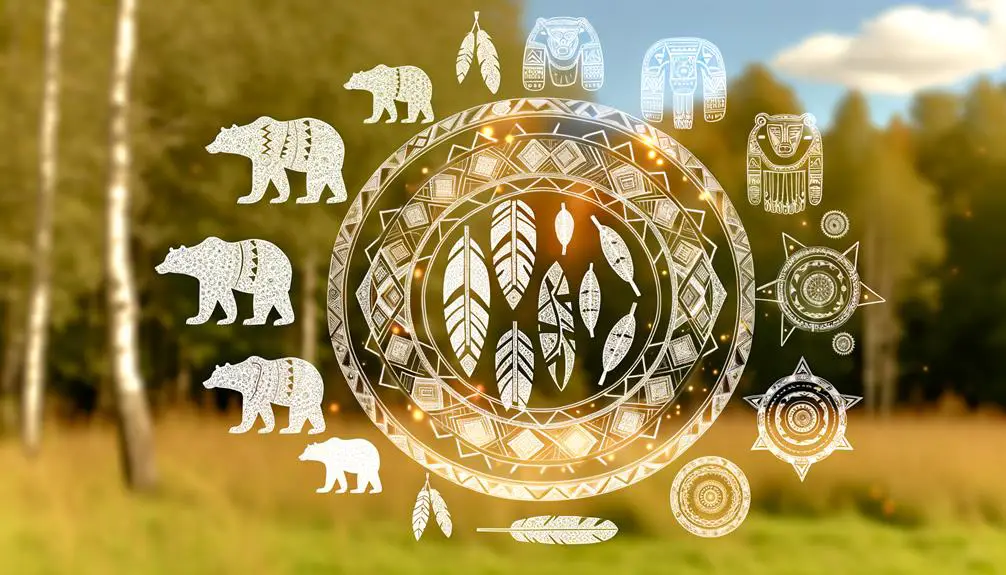What Is the Bear Symbol Meaning in Native American Culture?
In Native American culture, the bear symbol holds profound significance, embodying strength, resilience, and spiritual guidance. Historically rooted in folklore, art, and rituals, bears are revered as protectors and spiritual guides.
They symbolize introspection and renewal, mirroring their hibernation cycles. Bears are also associated with healing and medicine, often seen as powerful guardians against harm.
Variations exist among tribes; for example, the Sioux view the bear as a symbol of courage, while the Zuni see it as a healing force. Modern interpretations continue to honor these traditions through art, education, and cultural events.
By exploring further, the intricate layers of this symbol reveal much more.

Key Takeaways
- Bears are powerful spiritual guides symbolizing healing, protection, and nature connection.
- They represent strength, resilience, and survival skills in Native American culture.
- Bears are revered as guardians and protectors, especially of children and the vulnerable.
- They hold significant roles in healing practices and ceremonies for physical, spiritual, and emotional well-being.
- Different tribes attribute unique meanings to bears, such as courage, medicine, protection, wisdom, and introspection.
Historical Context

The historical context of Native American bear symbolism is deeply rooted in the spiritual and cultural traditions of various indigenous tribes across North America. Bears have been portrayed in Native American folklore, art, and rituals for centuries, often embodying the qualities of strength, bravery, and resilience.
The bear's role in tribal life extended beyond mere physical representation, influencing social structures and practices. For instance, the bear's hibernation patterns were mimicked in seasonal ceremonies, guiding agricultural and hunting cycles. Artifacts and cave paintings from different periods reflect the bear's revered status, underscoring its integral place within the cultural heritage of tribes such as the Lakota, Cherokee, and Haida.
This historical framework sets the stage for understanding the deeper spiritual significance attributed to the bear.
Spiritual Significance
Building on this historical framework, the spiritual significance of the bear in Native American culture is profound and multifaceted, encompassing themes of healing, protection, and connection to the natural world. The bear is revered as a powerful spiritual guide, often associated with shamanic healing practices, where its spirit is invoked for its curative powers. This majestic animal is also seen as a guardian, embodying strength and protection, safeguarding communities from malevolent forces. Moreover, the bear's hibernation cycles symbolize renewal and introspection, reinforcing a deep bond with nature's rhythms.
| Aspect | Spiritual Significance |
|---|---|
| Healing | Shamanic practices |
| Protection | Guardian spirit |
| Connection | Nature's rhythms |
Such elements encapsulate the bear's profound cultural resonance.
Symbol of Strength

The bear, in Native American symbolism, is often regarded as a potent emblem of strength, representing both physical power and spiritual resilience.
Historically, various tribes have revered the bear for its formidable presence and survival instincts, which epitomize the ideal of enduring strength.
This duality underscores the bear's role as a spiritual guide, illustrating the profound interconnectedness between physical prowess and inner fortitude.
Physical Power Representation
In Native American cultures, the bear is often revered as a potent emblem of physical power and resilience, symbolizing an unparalleled strength that is both physical and spiritual. This reverence is rooted in historical observations of the bear's formidable presence and capabilities.
The bear's sheer size and muscularity make it an apt symbol of might and endurance, elements pivotal for survival and protection. Native American tribes frequently incorporate bear imagery in their art, ceremonies, and storytelling to convey these attributes.
- Hunting prowess: Bears are adept hunters, embodying skill and tenacity.
- Protective nature: Bears fiercely protect their young, symbolizing guardianship.
- Endurance: Bears endure harsh climates, reflecting resilience.
- Physical dominance: Their strength is undeniable and awe-inspiring.
- Survival skills: Bears exemplify adaptability and resourcefulness.
Spiritual Resilience Embodiment
Beyond its representation of physical power, the bear in Native American cultures also serves as a profound symbol of spiritual resilience and inner strength.
Historically, many tribes have revered the bear as a guide through life's challenges, embodying the courage to face adversity with unwavering resolve.
The bear's hibernation cycle is particularly significant, symbolizing introspection and renewal. For instance, the Lakota associate the bear with healing and introspection, highlighting its role in spiritual rejuvenation.
Similarly, the Zuni view the bear as a mediator between the physical and spiritual domain, emphasizing its protective qualities.
Therefore, the bear transcends mere physicality, epitomizing a deep-seated resilience that is both introspective and empowering, guiding individuals through their spiritual journeys.
Bear as Protector
Among many Native American tribes, the bear is revered as a powerful protector, embodying strength, courage, and the ability to ward off harm. This reverence is rooted in cultural traditions and historical contexts where the bear's formidable presence was both a literal and symbolic guardian.
The bear's role as a protector is often depicted in tribal stories, artifacts, and rituals. Bears are seen as guardians of the tribe, especially children and the vulnerable. They symbolize the bravery required to face adversities and their physical prowess is a metaphor for communal resilience.
Additionally, bears are believed to possess deep knowledge of the land, symbolizing wisdom. They are thought to protect against negative spiritual forces, providing spiritual defense.
This multifaceted reverence underscores the bear's integral role in Native American culture.
Connection to Healing

The bear holds a significant place in Native American healing practices, symbolizing not only physical recovery but also spiritual and emotional well-being. Revered as a powerful medicine animal, the bear's hibernation patterns are often seen as a metaphor for deep introspection and rejuvenation. Various tribes believe that invoking the bear spirit can aid in overcoming illness and facilitating holistic recovery.
| Aspect | Significance |
|---|---|
| Physical Healing | Use of bear imagery and rituals in traditional medicine |
| Spiritual Guidance | Bears are considered spiritual guides leading to inner wisdom |
| Emotional Strength | Symbolizes resilience and the ability to face life's challenges |
| Cultural Practices | Integral to ceremonies and rituals focused on health and wellness |
This multifaceted symbol underscores the interconnectedness of body, mind, and spirit in indigenous healing traditions.
Influence in Totem Poles
In addition to their role in healing practices, bears are prominently featured in the intricate carvings of totem poles, serving as powerful symbols of family lineage, clan identity, and tribal heritage. Totem poles, created by various Indigenous tribes of the Pacific Northwest, encapsulate rich cultural narratives and genealogies.
The bear, often depicted with distinctive features, carries profound meanings:
- Strength and Courage: Emblematic of physical and spiritual strength.
- Protection: Symbolizes guardianship over the tribe.
- Leadership: Represents respected leaders or elders.
- Ancestral Spirits: Embodies the presence of revered ancestors.
- Connection to Nature: Reflects harmony with the natural world.
These attributes underscore the bear's integral role in conveying the collective values and historical continuity of Native American communities.
Bear in Storytelling

Within Native American oral traditions, the bear occupies a central role, often portrayed as a complex figure embodying wisdom, strength, and transformative power.
Various tribes, such as the Lakota, Iroquois, and Zuni, incorporate bear narratives to convey moral lessons and cultural values. These stories frequently depict the bear as a guardian and healer, reflecting its significance in the natural and spiritual domain.
The bear's hibernation cycle is symbolically linked to themes of death and rebirth, reinforcing its role in transformation and renewal. Additionally, bear tales underscore communal principles, emphasizing the importance of respect, bravery, and introspection.
Through these multifaceted narratives, the bear emerges as a pivotal archetype, deeply embedded in the cultural fabric and historical consciousness of Native American societies.
Ceremonial Roles
In numerous Native American cultures, the bear holds profound spiritual significance, often symbolizing strength, courage, and healing.
This revered animal is frequently featured in ritual practices, where its presence is believed to invoke protective and restorative powers.
Understanding the ceremonial roles of the bear provides valuable insights into the cultural and spiritual frameworks that underpin many Native American traditions.
Spiritual Significance
Bear symbolism holds profound spiritual significance in many Native American cultures, often serving as a central figure in various ceremonial roles. The bear is revered not only for its physical strength and resilience but also for its deep connection to the spiritual domain. It is frequently invoked in rituals that seek guidance, protection, and healing.
The ceremonial roles of the bear can be highlighted through various cultural practices:
- Healing ceremonies: Bears are believed to possess curative powers and are invoked to aid in the healing process.
- Vision quests: The bear spirit guides individuals on their journey to find personal and spiritual insights.
- Warrior rituals: Bears symbolize bravery and are often called upon to bolster courage.
- Seasonal celebrations: Bears are central to traditions marking the changing seasons.
- Clan totems: Many tribes honor the bear as a totem animal, representing unity and strength.
Ritual Practices
Ceremonial practices in Native American cultures often incorporate the bear as a symbol of strength and spiritual guidance, reflecting its revered status in various tribal traditions.
Historically, the bear has been central to many rituals, including healing ceremonies where its powerful spirit is invoked to provide protection and essentiality. Tribes such as the Lakota and Cherokee have conducted bear dances to honor the animal's role in the natural world and seek its favor.
Additionally, bear claws and pelts are often used in ceremonial garb, further embedding the bear's essence in spiritual practices. These rituals underscore the bear's integral role in fostering community resilience and spiritual well-being, demonstrating its deep-rooted significance across diverse Native American cultures.
Tribal Variations

Across various Native American tribes, the bear symbol holds unique meanings and significance, reflecting each tribe's distinct cultural narratives and historical experiences. For instance, the bear is often seen as a powerful totem and spiritual guide. Among the Sioux, the bear represents courage and physical strength; the Zuni associate it with healing and medicine.
Among the Navajo, the bear is viewed as a protector, while the Hopi see it as a symbol of fertility. The Cherokee revere the bear for its wisdom and introspective qualities.
These variations illustrate the rich tapestry of cultural interpretations surrounding the bear symbol.
Modern Interpretations
In the present day, the bear symbol continues to hold significant cultural relevance as it is increasingly integrated into contemporary artistic expressions and media representations.
This evolution reflects both a reverence for traditional meanings and an adaptation to modern contexts, illustrating the dynamic nature of cultural symbols.
Understanding this interplay between historical significance and current usage provides valuable insights into the ongoing cultural and artistic relevance of Native American bear symbolism.
Contemporary Cultural Relevance
While the bear symbol has deep historical roots in Native American cultures, it continues to hold significant contemporary relevance, reflecting evolving interpretations and applications in modern contexts. This enduring symbol is now often integrated into various facets of daily life, reinforcing its cultural significance.
- Cultural Identity: Used by Native American groups to assert their heritage and traditions.
- Healing Symbolism: Employed in modern holistic and spiritual healing practices.
- Environmental Advocacy: Adopted by activists to symbolize the protection of natural habitats.
- Educational Tools: Incorporated into curricula to teach about Native American history and values.
- Pop Culture: Featured in media and fashion, bridging traditional symbolism with contemporary expression.
These applications highlight the bear's enduring impact and adaptability in a modern setting.
Artistic Representation Evolution
Modern interpretations of the bear symbol in Native American art encompass a dynamic blend of traditional motifs and contemporary artistic innovation, reflecting the evolving cultural narratives and technological advancements of the present day. Artists integrate age-old symbolism with modern mediums such as digital art and mixed media, creating pieces that resonate with current societal contexts while honoring ancestral heritage. This evolution underscores the bear's enduring significance, adapting to new forms of expression without losing its cultural essence.
| Traditional Elements | Modern Techniques |
|---|---|
| Totemic Imagery | Digital Illustration |
| Tribal Tattoos | Mixed Media |
| Hand-carved Totems | 3D Printing |
| Storytelling Art | Virtual Reality |
These artistic evolutions bridge past and present, enriching the cultural tapestry.
Symbolic Adaptation in Media
The symbolic adaptation of the Native American bear motif in contemporary media reflects a nuanced interplay between historical reverence and modern interpretative frameworks. This motif's journey from traditional storytelling to modern cinematic and literary representations exemplifies how cultural symbols are both preserved and transformed.
Contemporary media often reinterpret the bear symbol, incorporating it into narratives that blend indigenous wisdom with universal themes of strength, protection, and introspection.
- Films: Utilize the bear to symbolize resilience and survival.
- Literature: Depicts the bear as a guardian spirit and moral compass.
- Video games: Feature the bear as a powerful totem or guide.
- Television: Uses the bear to explore themes of identity and heritage.
- Art: Reinterprets the bear through various contemporary lenses.
These adaptations highlight the bear's enduring significance and evolving representation.
Cultural Preservation

Preserving the cultural heritage of Native American tribes involves safeguarding the profound symbolism of the bear, which embodies strength, courage, and resilience across various indigenous communities. This cultural preservation is crucial for maintaining identity and continuity. Efforts include education, storytelling, and the protection of sacred sites where bear imagery is prevalent. The table below highlights key aspects of these preservation strategies:
| Aspect | Description |
|---|---|
| Education | Teaching younger generations about bear symbolism. |
| Storytelling | Oral traditions that convey the bear's significance. |
| Sacred Sites | Protection of locations with bear symbolism. |
| Cultural Events | Festivals and rituals celebrating the bear. |
| Artistic Expressions | Preserving bear imagery in art and crafts. |
These initiatives secure the enduring legacy of the bear within Native American cultures.
Conclusion
The Native American bear symbol, a timeless emblem, intertwines historical reverence and spiritual significance, embodying strength, protection, and healing.
Its ceremonial roles and varied tribal interpretations speak volumes about its integral place in cultural narratives.
As modern interpretations evolve, the bear symbol remains a steadfast guardian of cultural heritage, ensuring the preservation of ancient wisdom.
Like a sentinel of tradition, it bridges the past and future, safeguarding the rich tapestry of Native American identity.




